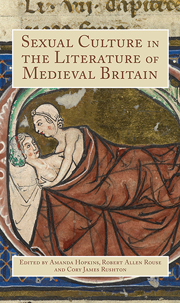Book contents
- Frontmatter
- Contents
- Introduction A Light Thrown upon Darkness: Writing about Medieval British Sexuality
- 1 ‘Open manslaughter and bold bawdry’: Male Sexuality as a Cause of Disruption in Malory's Morte Darthur
- 2 Erotic (Subject) Positions in Chaucer's Merchant's Tale
- 3 Enter the Bedroom: Managing Space for the Erotic in Middle English Romance
- 4 ‘Naked as a nedyll’: The Eroticism of Malory's Elaine
- 5 ‘How love and I togedre met’: Gower, Amans and the Lessons of Venus in the Confessio Amantis
- 6 ‘Bogeysliche as a boye’: Performing Sexuality in William of Palerne
- 7 Fairy Lovers: Sexuality, Order and Narrative in Medieval Romance
- 8 Text as Stone: Desire, Sex, and the Figurative Hermaphrodite in the Ordinal and Compound of Alchemy
- 9 Animality, Sexuality and the Abject in Three of Dunbar's Satirical Poems
- 10 The Awful Passion of Pandarus
- 11 Invisible Woman: Rape as a Chivalric Necessity in Medieval Romance
- Notes on Contributors
- Index
6 - ‘Bogeysliche as a boye’: Performing Sexuality in William of Palerne
Published online by Cambridge University Press: 05 August 2014
- Frontmatter
- Contents
- Introduction A Light Thrown upon Darkness: Writing about Medieval British Sexuality
- 1 ‘Open manslaughter and bold bawdry’: Male Sexuality as a Cause of Disruption in Malory's Morte Darthur
- 2 Erotic (Subject) Positions in Chaucer's Merchant's Tale
- 3 Enter the Bedroom: Managing Space for the Erotic in Middle English Romance
- 4 ‘Naked as a nedyll’: The Eroticism of Malory's Elaine
- 5 ‘How love and I togedre met’: Gower, Amans and the Lessons of Venus in the Confessio Amantis
- 6 ‘Bogeysliche as a boye’: Performing Sexuality in William of Palerne
- 7 Fairy Lovers: Sexuality, Order and Narrative in Medieval Romance
- 8 Text as Stone: Desire, Sex, and the Figurative Hermaphrodite in the Ordinal and Compound of Alchemy
- 9 Animality, Sexuality and the Abject in Three of Dunbar's Satirical Poems
- 10 The Awful Passion of Pandarus
- 11 Invisible Woman: Rape as a Chivalric Necessity in Medieval Romance
- Notes on Contributors
- Index
Summary
The Middle English alliterative verse William of Palerne (sometimes known by its early title, William and the Werewolf) is a fourteenth-century translation of the Old French Guillaume de Palerne. Both the English and French narratives tell the interlinked stories of William, a prince of Palerne, who escapes from the plotting of his murderous uncle with the help of a benevolent werewolf, and of Alphons, the Spanish prince who is forced into lycanthropic form by his necromantic stepmother. There are, however, some striking differences between the insular and continental versions of the story (which also appears in later English and French prose versions, as well as an Irish adaptation), and this essay will go some way to examining what we might note as a particular thematic concern of the Middle English verse narrative. In his 1985 edition of the poem, G. H. V. Bunt argues that the English poet ‘has written a very different poem from his French source’, and I would like to offer some exploration of themes of sexual and gender performance which I believe characterize the English poem particularly. The first half of the English William reveals a preoccupation with disguise and role-playing, which is not found in the French source text. This is especially apparent in the presentation of the relationship between William and Melior, the emperor of Rome's daughter, and in their meeting, attraction and elopement.
- Type
- Chapter
- Information
- Sexual Culture in the Literature of Medieval Britain , pp. 85 - 98Publisher: Boydell & BrewerPrint publication year: 2014



